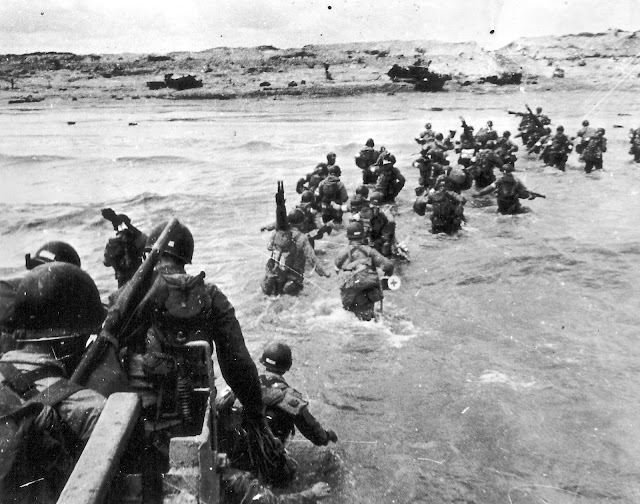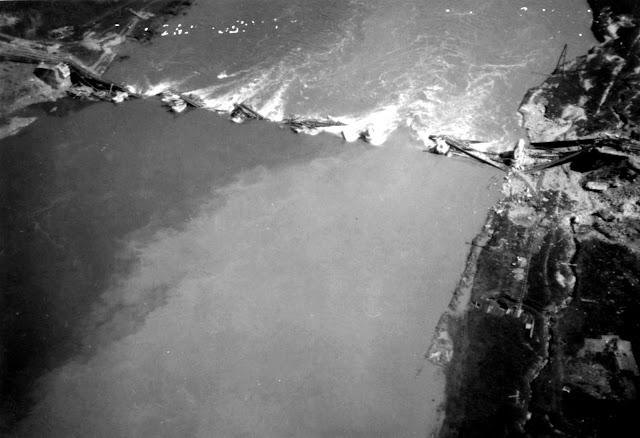PFC. John J. (Joe) Gilchrist, WWII: Died after capture of Saint-Lo
ô Pictured is the granite marker for the Sleepy Hollow Cemetery grave of Pfc. John Joseph (Joe) Gilchrist of Irvington. He fought in all the major European theater campaigns of World War II — North Africa, Sicily and Normandy — and died north of the devastated strategic French crossroads town of Saint-Lô on Aug. 5, 1944.
Pictured is the granite marker for the Sleepy Hollow Cemetery grave of Pfc. John Joseph (Joe) Gilchrist of Irvington. He fought in all the major European theater campaigns of World War II — North Africa, Sicily and Normandy — and died north of the devastated strategic French crossroads town of Saint-Lô on Aug. 5, 1944.
Each of the Irvington Six had joined the 9th Division in January 1941, three months after Congress had passed the nation’s first peacetime draft and 10 months before Pearl Harbor.
The six soldiers and their 9th comrades would go on to spearhead Allied liberation offensives Operation Torch in North Africa, Operation Husky in Sicily and Operation Overlord in Normandy, France in World War II. They trained together at Fort Bragg, North Carolina (renamed Fort Liberty in 2023) and in England before Torch, Husky and Overlord.
Four were each awarded the Purple Heart for wounds received in battle, one mortal. All but Joe survived to return to Irvington in 1945. Joe died in a hospital in France on Aug. 5, 1944 shortly after Germany abandoned the strategic French supply and transportation crossroad city of Saint-Lô in advance of the 9th Division’s approach. It’s unclear when Joe was mortally wounded, perhaps a day, maybe more, before he died, but it’s possible we will ever know.
If his friends in the 9th knew, they never said.
In Sicily, the 9th was part of Patton’s 7th Army that captured the key city of Messina.
Four days after D-Day, June 10, 1944, the 9th landed on Utah Beach, cut off the key Cotentin Peninsula, was among the first units to capture the key deep-water French port of Cherbourg, then moved on to the capture of the key crossroads city of Saint-Lô. The 9th was part of Gen. Omar Bradley’s 12th Army Group in that effort which also included Irvington residents in the 1st, 4th and 30th infantry divisions. It was during the pincer movement by 12th Army Group on Aug. 5 to close that pocket that Gilchrist fell. It appears he was actually mortally wounded and died in a field hospital not long after being wounded.
A native of Hacketstown, County Carlow, in the newly established Irish Free State which had been a vassal state of Great Britain until 1922, Joe arrived in the U.S. with his Irish parents, John James Gilchrist – a farmer – and wife Sarah Anne (Cooper) Gilchrist in 1929. Born on March 22, 1913, Joe was 16 when he arrived and had quit school after finishing the eighth grade in Ireland.
It’s unclear why the Gilchrists emigrated, but it might have traced to their religious identity. Unlike the vast Roman Catholic majority of the Irish Free State, the Gilchrists were Protestants, members of the Anglican Communion’s Church of Ireland. And Protestants, who made up 10 percent of the population in 1891 of what was to become the Irish Free State, were leaving the country in droves, most emigrating to Protestant-friendly England or its remaining Northern Irish Ulster provinces. In Irvington, the Gilchrists eschewed North Broadway’s Episcopal church, St. Barnabas, in favor of the Irvington Presbyterian Church next door.
By 1930, the children, mostly adults by then, chipped in to help achieve the American dream: eldest sister Mary, 25, worked as a maid; Harry, 24, was employed at a gas station; Sam, 23, and Annie, 22, worked at the General Motors auto factory in North Tarrytown (today’s Sleepy Hollow). The only children not working were daughters Ada, 19, and Connie, 15. Within a few years, the family would move to the immigrant-friendly hamlet of East Irvington, known as Little Dublin because of its large Irish population.
The Gilchrists set up housekeeping in a side-by-side duplex at 70 E. Sunnyside Lane, a house that still exists. In the 1940s they’d move into a single-family house at 14 Croton Place. But it was the Little Dublin location that would mean the most to Joe. For it was his East Irvington neighbors, Pasquale Edward “Patsy” Reale Jr. of 122 E. Sunnyside Lane and Louis Charles DiFalco of 180 Mountain Road, a mile away, who all got their draft notices with him on Jan. 16, 1941.
Also getting a draft notice that day was Frank Peter Mauer of 14 Aqueduct Lane, Joe Gilchrist’s co-worker by then at the Anaconda Cable & Wire Co. of Hastings.
All four soldiers were assigned to train for the Army’s 9th Infantry Division at Fort Bragg, outside Fayetteville, N.C. They were joined at Fort Bragg by fellow Irvingtonians William Francis “Willie” Riolo of 102 Main Street — known about town as “Meech” — and Joseph John “Joe” Vizvary, of 3 West Sunnyside Lane, who’d both been drafted a few weeks earlier and inducted at Fort Dix, N.J. Riolo and Vizvary were transferred from Dix to Bragg the day the other four soldiers received their draft notices — Jan. 16, 1941.
Gilchrest, DiFalco and Reale were assigned to the 47th Infantry Regiment, Riolo and Vizvary to the 60th Infantry Regiment both regiments assigned to the 9th Division. Mauer’s regiment is uncertain but his, too, was in the 9th Division.
The Irvington Six saw action in all the major Allied sectors of World War II. They were first to land on the beaches of French Morocco to open Operation Torch against the Vichy French allies of Adolf Hitler in French North Africa on Nov. 8, 1942. Having succeeded in liberating French North Africa, the 9th was called to Sicily as reinforcements to take part in Patton’s assault on Messina in August 1943. On June 10, 1944, the six were sent to Normandy, a battle-tested division that would expand the bridgehead less experienced troops had established at Omaha and Utah beaches on D-Day four days earlier. The 9th was expected to crush and repel German defenders. It did.
In Normandy, the 9th Division fought its way through the tangled, dense hedgerows dating back perhaps as far as Roman-era Gaul, of the bocage, a French term referring to farmland delineated by planted hedges and trees used as walls and fences. The so-called Battle of the Hedges or Battle of the Hedgerows was key first to allowing the 9th to help bring the deep-water port of Cherbourg into Allied hands, key to the Allies’ supply efforts. Next the hedges protecting German defenders had to be conquered to allow the 9th and the Allies to advance inland, liberating the French countryside, including Saint-Lô.
Gilchrist was the third of four members of the Irvington Six to be wounded in battle, in his case mortally. Louis DiFalco had suffered shrapnel wounds in French North Africa on March 28, 1943 and was hospitalized for three months. Joe Vizvary was wounded twice. In May 1943 he suffered a shrapnel wound to his arm in North Africa and was treated and released soon after. In July 1944, just before Gilchrist’s death, he suffered a shrapnel wound to his chin in France and was quickly treated and released back to the front.
Reale was wounded and hospitalized in France sometime before April 25, 1945. His war would have been over. The Germans surrendered on May 8, 1945.
It’s not clear which cemetery in France held Pfc. Gilchrist's remains until they could be returned to the U.S., but it was likely the temporary American St. Laurent Cemetery in Colleville-sur-Mer. It was established on June 8, 1944 two days after D-Day and is now known as the Normandy American Cemetery and Memorial overlooking Utah Beach. Less likely would have been the American St. James Cemetery established Aug. 4, 1944, the day before Joe’s death. That cemetery is now the Brittany American Cemetery and Memorial in Montjoie-Saint-Martin, France.
Whatever the temporary location, Pfc. Gilchrist’s remains were returned to Irvington in late August 1948. The fallen hero lay in repose at Edwards Funeral Home in Dobbs Ferry on Friday, Sept. 10 with an honor guard from Irvington Post 2911 Veterans of Foreign Wars on duty all night and through the memorial service in the Edwards chapel on Saturday, Sept. 11 officiated by the Rev. Philip W. Furst of Irvington Presbyterian Church.
Burial was with full military honors at Sleepy Hollow Cemetery also on Sept. 11.
AUTHOR’S NOTES: If all this sounds like a family affair, it truly was …
… Joe Vizvary’s younger brother John Joseph, born in 1920, was a member of the 395th Armored Field Artillery Unit that saw major action at the Battle of the Bulge. The Vizvarys, Kaust (Constantine) and wife Anna, were ethnic Hungarians from today’s Slovak Republic, immigrated to the U.S. from the Austro-Hungarian Empire in 1911 and 1912, respectively. … Constantine was the caretaker at Sunnyside, the estate of Washington Irving’s heirs on West Sunnyside Lane. …
… Willie Riolo was one of nine children born to Italian immigrants Luigi and Francesca (Louis and Frances) Riolo who came to the U.S. in 1900. Luigi was a tailor at the Kyle School for Boys on North Broadway by 1930. Willie was one of five Riolo brothers who served in the Army in World War II. The others, each with year of birth noted, were George Anthony (1908), Anthony Jerome (1921), John Lewis (1923) and Joseph John (1920). Willie was born in 1918. …
… Louis DiFalco’s brother Mark fought in the infantry in Europe and his brother Tuley fought in the Navy in the Pacific theatre. …
Links to similar personal stories about Irvington heroes who gave their lives for their country*
◼ Pfc. Cuthbert Powell Sinkking: Class of '42 gave 3 of its own to the ages
◼ Pfc. John Joseph (Joe) Gilchrist: Died after capture of Saint-Lo
◼ Lt. (j.g.) George Eddison Haines: Lost at sea, awarded Silver Star
◼ Pfc. Joseph Thomas Costello: Teen lost life in Battle of Mindanao
◼ MSgt. James Peter Kelley: Survived WW II and Korea; died in fall
◼ S1 Archibald Ronald: Lost on next-to-last Navy ship sunk by U-boat
◼ TSgt. Raffaele R. (Ralph) Reale: A hero's life ended on East Sunnyside Lane
◼ Sgt. Robert F. Morrison: Took fight to the enemy, fell in Alsace
◼ Lt. Col. George W. Beavers Jr.: Re-upped as private; died on war's eve
◼ F2 Claude L. Bronnes: Went down with the Atlanta at Guadalcanal
◼ MMLC William James Downey: Died aboard ship off West Coast
◼ Pvt. Alick Main Ian: Died taking Aachen, first German city to fall in WWII
◼ Pfc. George Mills Hill Jr.: Survived Okinawa, only to fall in South Korea
◼ Pvt. Peter R. Robinson: Lost to shadows of time over Pacific, answers never found
WORLD WAR I













Comments
Post a Comment